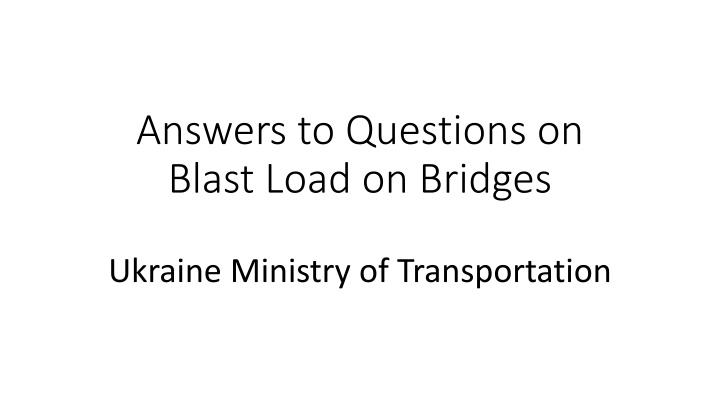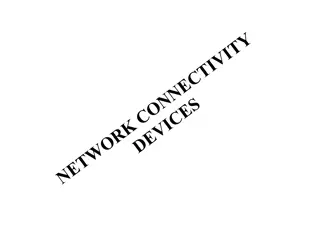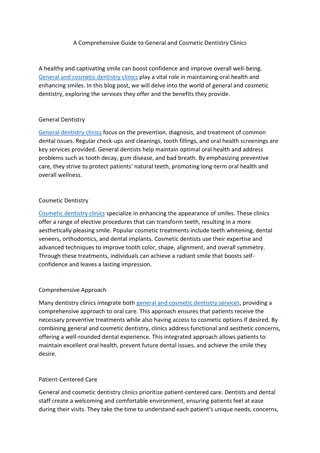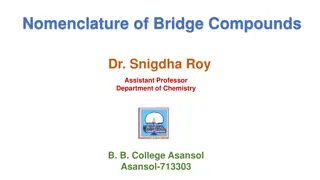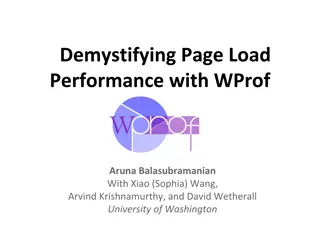Blast Load on Bridges: Technical Assessment & Impact Analysis
Criteria for assessing post-explosion bridge condition, calculation of explosive loads, girder reuse analysis, concrete strength variation with blast wave distance, effects on metal girder structures & concrete, and more insights on blast load impact.
Download Presentation

Please find below an Image/Link to download the presentation.
The content on the website is provided AS IS for your information and personal use only. It may not be sold, licensed, or shared on other websites without obtaining consent from the author.If you encounter any issues during the download, it is possible that the publisher has removed the file from their server.
You are allowed to download the files provided on this website for personal or commercial use, subject to the condition that they are used lawfully. All files are the property of their respective owners.
The content on the website is provided AS IS for your information and personal use only. It may not be sold, licensed, or shared on other websites without obtaining consent from the author.
E N D
Presentation Transcript
Answers to Questions on Blast Load on Bridges Ukraine Ministry of Transportation
Answers to Questions on Blast Load on Bridges Ukraine Ministry of Transportation 1. Criteria for assessing the technical condition of the bridge after the explosion. There are no specific guidelines established for inspection of bridges after the explosion. A bridge after an explosion should be inspected to assess the condition of critical components such as piers and abutments, girders and the deck, similar to seismic inspection. These components should be in good condition to carry desired load (whether live load from traffic or military and other necessary vehicles). For over-deck explosion, inspection should focus of deck and girders, although substructure components should also be inspected. For under-deck explosions, piers / abutments, foundation interface with piers, girders and bearings should be inspection. To secure a bridge again damages from blast loads, a simple bridge security manual can be used, although it may have (file:///D:/Users/Anil/Downloads/dot_17132_DS1.pdf) For test data and blast resistant detailing of bridges, NCHRP Report 645 provides useful information (https://onlinepubs.trb.org/onlinepubs/nchrp/nchrp_rpt_645.pdf). limited applications in Ukraine.
Answers to Questions on Blast Load on Bridges Ukraine Ministry of Transportation Calculation of bridges for explosive loads. Generally, effect o explosive loads on bridges is calculated using hydro-codes, such as LS-DYNA. The software calculate explosive loads using experiments-based program, such as ConWep developed by the US Department of Defense. An example of calculation of blast loads on bridge girders can be found in http://fau.digital.flvc.org/islandora/object/fau%3A3459/datastream/OBJ/view/Blast_explosion_resistant _analysis_of_composite_steel_girder_bridge_system.pdf. 2. 3. Ability to reuse the girder structure and structural elements. The reuse of girder and structural elements after a blast event really depends on the extent of damage. Girders and structural elements may be reusable if the extent of damage is minimal and they have sufficient capacity to carry expected loads. Hence, analysis to estimate remaining capacity and estimated loads should be carried out before deciding to reuse. 4. How the strength of concrete changes with distance from the epicenter of the explosion. The effect of high speed of blast loading is considered in Hydrocodes by including strain-rate based material strength models. Strain rate may affect the behavior of concrete. However, its strength is not directly a function of distance from the center of the explosion. Strain-rate effect, which may change from the epicenter of blast load may give the impression of blast load dependent strength of concrete. Generally, increasing distance from the blast center will result in lesser damage to concrete members.
Answers to Questions on Blast Load on Bridges Ukraine Ministry of Transportation 5. What is the peculiarity of the impact of the blast wave on bridges with a metal girder structure? Metal member may be more vulnerable to blast load, compared to concrete, due to member size and inertia resistant force. Their failure may be caused because of large plastic deformation and metal rupture. Significant damage to steel girder may cause collapse of the entire bridge. 6. Physical and chemical effects of explosive load on concrete, reinforcement. Physical effects of explosion on concrete and reinforcement are spalling, breaching and shearing of girders and columns. A shearing of column or girders (or formation of plastic hinge is the most significant one and can lead to complete or partial collapse of the bridge, depending on the type of bridge (single span versus multiple spans, continuous, etc.). Chemical effects are long-term and are generally not considered. 7. Influence of explosion on the condition of foundations. In case of above-deck blast, effect on foundations may not be significant. However, in case of under-deck explosion, bridge piers may be sheared from the foundation if the blast wave cause significant damage to bridge piers, depending on the distance of blast wave center from the pier.
Answers to Questions on Blast Load on Bridges Ukraine Ministry of Transportation 8. What methods can be used to obtain reliable data on the condition of structures due to impact? Detailed visual inspection can provide first estimate of damage to the bridge. Safety of the bridge can be determined based on visual inspection data using basic principles of structural inspection: extent of concrete spalling, cracks or shearing of members, plastic hinge formation. For more detailed and reliable information, load testing can be carried out by installing strain or displacement sensors and running a truck of expected loading on the bridge. If time permissible, modeling using software, such as LS-DYNA where observed damages are incorporated in the model, can also be carried out. 9. What documents must be provided to the design organization from the customer before the start of work to ensure safety. The bridge and all components should be designed to survive blast loads, if the bridge is critical. Hence, design organization should be provided information regarding importance of the bridge and potential levels and locations of explosion risk to the bridge. countermeasures, bridge can should be protected using measures such as barriers / standoff distance and intelligence. Besides structural
Answers to Questions on Blast Load on Bridges Ukraine Ministry of Transportation 10. What regulations determine the stability of soils in the explosion zone? High intensity stress waves from ground explosion impact the ground surface and form a crater. Hence, surface near bridge foundations should be sufficiently strong and thick to prevent formation of deep crater near bridge foundation. This can prevent a bridge from collapsing if there is an explosion near bridge foundations. Some studies have shown that detonation wave destabilized the interior of the soil body, resulting in material failure. Hence, bridge foundations should be designed for high stress waves. 11. And in which cases it is possible to replace a part of a design? What composite materials are used in the restoration of man-made structures? If the bridge survived explosion and has not collapsed, but some of its components are damaged, such as pier has spalled, including damage to the core concrete and deck has crater forming, it is possible to replace the pier by a temporary or permanent pier and replace part of the deck. This decision to replace really depends on field condition and inspection. Components, such as spalled piers can also be rapidly repaired by materials such as fiber-reinforced plastics (FRP). Wrapping FRP around a damaged bridge pier and injecting epoxy cement between the FRP and the damaged column can restore the capacity of the pier in relatively shorter amount of time. Damaged foundation can also be repaired by high strength jet grouting in the soil 12. What are the measures to increase the resilience of an artificial structure from the effects of an explosive wave? Resiliency of an artificial structure against blast damage can be increased by (1) greater standoff, (2) barriers near bridge piers, and (3) alternative load paths for girders and other superstructure members. Bridge components should be designed for elastic behavior for most-probable blast load after consider the effects of standoff distance and barriers. Wrapping bridge piers by FRP can also improve their resistance against blast loads.
Answers to Questions on Blast Load on Bridges Ukraine Ministry of Transportation 13. Impact on the underground part of buildings. Generally underground part of the building will have lesser impact on the underground part of a building since the soil will absorb shock from explosion and will form a crater in the soil. There will be effect on underground part of the building if crater depth is close to the top part of the underground part of the building. However, the building occupants will feel the vibration from the shock wave on the ground. 14. Is it possible to draw conclusions about the need to restrict or close traffic based on the results of visual inspection, knowing that the building was exposed to the blast wave? I am assuming that this is about stopping traffic because of damage to building. Obviously, part of inspection will be to immediately inspect for debris, which will poser danger to pedestrians and traffic. Other part will be to inspect if there is significant damage to the foundation of the building and columns and if there is any sideway sway in the building because of blast. If these signs are visible, traffic should be stopped. Inspecting by drones can give good information about lateral sway of the building. 15. The use of reinforcing bandages made of carbon fiber. See answers to question number 11. 16. What will be the priority in case of damage to the bridge on the verge of complete destruction or restoration? Will there be a preference in full recovery or will they try to recover? Full recovery of the bridge may take several months. Depending on the importance of the bridge, partial recovery using deployable bridge technology is advisable if the bridge is urgently needed to mobilize emergency military and rescue vehicles. USArmy Corps of Engineers has been using this technology.
Answers to Questions on Blast Load on Bridges Ukraine Ministry of Transportation 17. Which elements of the bridge in the first place take the blow from the blast wave? It depends on the location of blast load. For above deck explosion, it is obviously the deck and portions above the deck in case of through truss bridges. In case of under deck blast, it will be piers and superstructure under the bridge. In case the blast is on the side of the bridge, it may be piers or side girders. 18. What tools should be used to protect existing and new bridges from the shockwave in the future? New bridges can be designed, and existing bridges can be retrofitted for blast load effects by modeling in hydrocodes, such as LS-DYNA. This approach is called hardening. However, one of the best approaches to minimize damage because of blast loads is through standoff distance and use of barriers to prevent shock waves directly hitting bridge components. Uplift restrained bearing can be used to prevent decks from uplifting during under-deck explosions. Guidelines to design and retrofit bridges https://onlinepubs.trb.org/onlinepubs/nchrp/nchrp_rpt_645.pdf). against blast loads can be found in 19. The impact of the explosion on the foundations of the building. Please see answer to question 13. 20. Detection of foundation defects without excavation. It is difficult to detect foundation defects without excavation. Visual inspection can indicate foundation defects if there are partial or differential settlements in any part of the foundation. Load rating is another approach. Foundation movement can be monitoring by loading the bridge with expected level of load. permanent settlement will point to foundation defects. Any substantial settlement and
Answers to Questions on Blast Load on Bridges Ukraine Ministry of Transportation 21. How does the explosive load affect the change in strength of reinforced concrete? See answer to Question No. 4. 22. Taking into account the impact of the blast wave on the adjacent to the damaged areas of the bridge. Damage can be assessed through detailed visual inspection. 23. How to find out if the demining of this object was carried out? I am not qualified to answer this question if it pertains to removal of mines. 24. How to identify the impact on the foundations of the consequences of damage, and their classification? Please see answers to questions 7 and 10. 25. Temporary symbiosis of steel structures with reinforced concrete. I am assuming this question pertains to composite connection between the deck and steel girders. Generally, a bridge with composite deck will be more resistant to blast load because both the deck and girder masses will act jointly to resist blast load and local failure in one of the girders may not cause complete collapse of the bridge. 26. The difference in the survey of ordinary bridges and bridges damaged by explosions. An ordinary bridge may not need detailed visual inspection. However, a bridge damaged by blast loads may require detailed visual and hands on inspection to determine if the bridge can carry vehicles. Suitability of a blast damaged bridge in carrying certain military / vehicle load can be ascertained by loading the bridge by that load and measuring the resulting deflection. 27. What calculations need to be made to determine the impact of an explosive load? See answer to Questions 1 and 2.
Answers to Questions on Blast Load on Bridges Ukraine Ministry of Transportation 28. Are the effects of the blast wave in the soil studied and what methods exist to identify the effects on the foundations of buildings. Please response to questions 7 and 10. 28. Determination of the bearing capacity of an existing bridge, if reinforcement is unknown. 30. What is the dependence of the explosive load on the mass of the charge and the distance of the epicenter of the explosion. How does the explosive load affect the stability of bridges depending on the area of individual bridge structures. Damage will increase with increase in the mass of charge and reduction in the distance from the center of the explosion. I have answered to the effect of explosive loads on the stability of the bridge in many other questions. 31. The most common irreversible destructive processes. Progressive collapse is the most common irreversible destructive process. This happens when there is not sufficient alternative load path. For example, in our simulation for under-deck blast, deck got lifted from the bearings during blast loads. At the same time, piers swayed laterally. When deck came down, piers were not in place to support the deck, resulting in complete collapse of the bridge. 32. The equipment is necessary for inspection in the field. Personal protective equipment, commonly referred to as "PPE", is equipment worn to minimize exposure to hazards that cause serious workplace injuries and illnesses. These injuries and illnesses may result from contact with chemical, radiological, physical, electrical, mechanical, or other workplace hazards. Personal protective equipment may include items such as gloves, safety glasses and shoes, earplugs or muffs, hard hats, respirators, or coveralls, vests and full body suits. 33. Is it possible to assess the impact of the explosive load on the elements of the foundations of bridges? Besides bridge inspection, Static/Dynamic load testing with design trucks on the bridge may be helpful to determine the condition. See answer to question 20.
Answers to Questions on Blast Load on Bridges Ukraine Ministry of Transportation 34. Do they take into account the effect of temperature during the explosion on metal structures? If so, how? No. Only shock waves. Temperature effects come after shock waves. 35. What are the consequences of explosion damage? Depending on the location of damage, distance from explosion center and equivalent amount of TNT, damage can be minor, major and severe. Material damage (spalling, cracking / shearing) is the most common form of damage. 36. What are the modern and fast methods of repairing damage from an explosion? See answers to questions 1 and 11. 37. Are there deformations (damages) due to the explosion in structures that are clearly not destroyed? Even though the structure is not clearly destroyed, there may be deformation if there is plastic hinge formation at joints. All joints and connections of the structure should be inspected. 38. Methods of restoration of partially destroyed load-bearing structures. Depending on the field inspection, structure can be restored temporarily based on commonly accepted structural engineering practice. However, the structure may need to be replaced eventually. 39. Ways of protection when designing bridges from a destructive blast wave. Please see answer to question 12.
Answers to Questions on Blast Load on Bridges Ukraine Ministry of Transportation 40. Is a visual inspection of damage to the bridge structure sufficient? Modern and up-to-date technologies for eliminating identified generations. In addition to visual inspection, you can use drone technology to carry out reliable inspection of damage to bridge components. 41. How to model the load on the calculated scheme of the blast wave, what coefficients and load class to take? Please see answer to questions 1 and 2. 42. What effect does the explosion have on unaffected surviving supports? Unaffected surviving supports may become overstressed because of shockwave on other components. Signs of cracking permanent deformation should be observed during inspection. 43. Methods for assessing the condition of bridge structures. Visual inspection in combination with drone inspection will be helpful in assessing the condition. Besides bridge inspection AASHTO element inspection, Static/Dynamic load testing with design trucks on the bridge may be helpful to determine the condition.
Answers to Questions on Blast Load on Bridges Ukraine Ministry of Transportation 44. Influence of dynamic shock wave loads on the stability of artificial structures and bridges. Please see the answer to question 12. Depending on the location, distance and explosive weight, these structures may suffer different levels of damages. Material damage (spalling, cracking / shearing) is the most common form of damage. 43. Principles of inspection of embankments and approaches to bridges. What parameters are checked. Stamp tests. Coefficient of compaction. Determination of the zone of embankment destruction on the approaches to bridges, man-made structures and embankments. Impact on soil structure after explosion and long-term thermal exposure. I don t have expertise in this area. However, a well compacted soils and embankments will sustain lesser damages. Formation of crater because of explosion may be the most common form of damage. Covering embankments by rock and boulders may prevent excessive damages to embankments. Long term thermal exposure may not be a significant concern. Damages during and immediately after the explosion may be the most important concern.
